The African dog rose is usually admired for its flowers, but it also plays host to many small creatures, including a species of butterfly, enabling it to complete its life cycle from egg to adult. Surprising as it was to find one plant sustaining so much life, it surprised me more that it sustained so much interest in me.
I have written about the African dog rose before (see here), but only recently have I been observant enough to start noticing the various small creatures depending on it for shelter and sustenance.
Among the first things I noticed were some tiny creamy eggs on the top of some of the leaves and I developed the habit of checking on them once or twice a day.
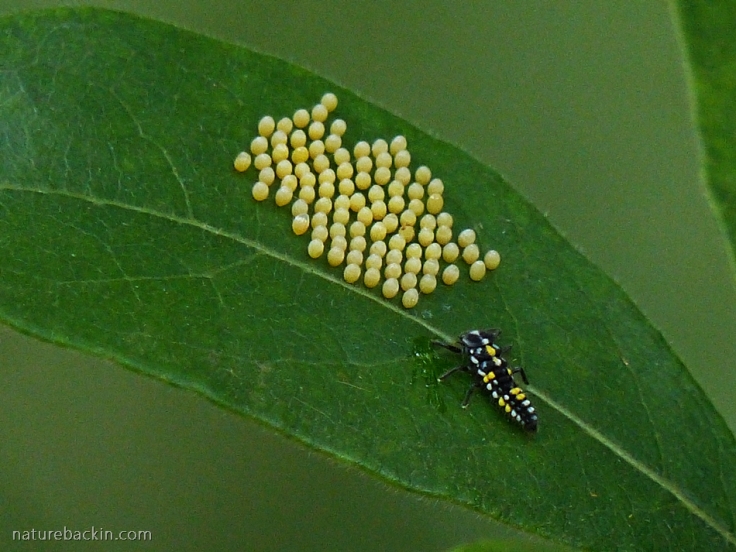
There were several clutches of eggs distributed on separate leaves of the African dog rose in our garden. Soon enough I noticed that most of the egg clutches each had a tiny creature in attendance and it soon became evident that these curious black, white and yellow creatures were feeding on the eggs

After a few days the eggs started darkening in colour, becoming a reddish-brown. The attending creatures continued to eat the eggs. I was pretty sure that these tiny insects were the larvae of ladybirds, but I was not able to identify which species in particular

Perhaps this picture gives a better sense of scale? Each egg is less than the size of a match head. I thought it likely that they were the eggs of a butterfly, so each time I visited the African dog rose, I kept an eye open for butterflies, and noticed several species flitting by

After several days I was fortunate enough to come across a butterfly in the act of laying eggs on a leaf of the same African dog rose (Xylotheca kraussiana) at the bottom of our garden
After checking in my pocket guide to butterflies in South Africa, I was confident that the butterfly laying eggs in the dog rose was a Blood-red Acraea (Acraea petraea) and to clinch it, the book stated the eggs are “laid in clusters on Xylotheca kraussiana”.
Since then I have learned that although some species of adult butterflies can eat nectar from several varieties of plant, more often than not the larvae (caterpillars) can feed only on specific species of plants. Although it should be obvious, it is sometimes overlooked that the butterflies that we so enjoy and treasure can only be butterflies if they are also caterpillars. And when they are caterpillars (or larvae) they need to eat, and for them to be able to eat, the butterflies (adults) need to lay their eggs on the plants that are specific host plants for the specific species of butterfly.
The Blood-red Acraea has only one larval food plant: the African dog rose (Xylotheca kraussiana). So if we did not have an African dog rose in our garden as a larval food plant we would not have Blood-red Acraea butterflies either.
For more on a larval host plant, see my post on the Cross-berry tree hosting processionary caterpillars here.
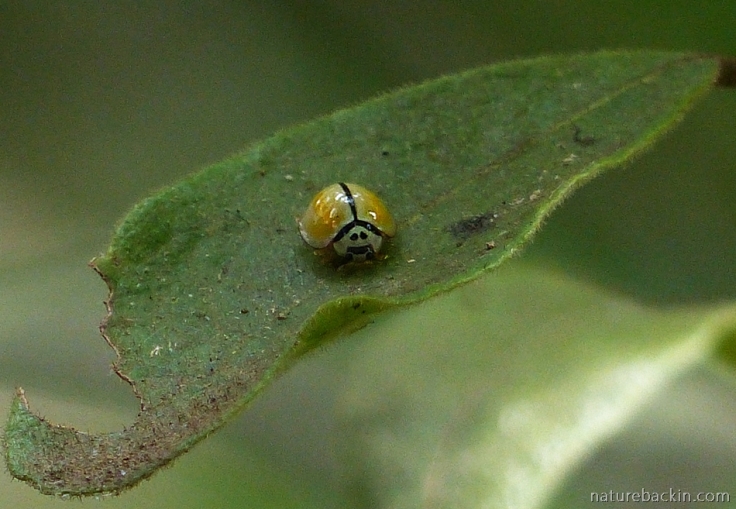
I was delighted to spot this Black-ringed ladybird on a leaf in the same African dog rose plant where the ladybird larvae were eating the eggs of the Blood-red Acraea butterfly. Presumably it is the same species as the larvae that I saw
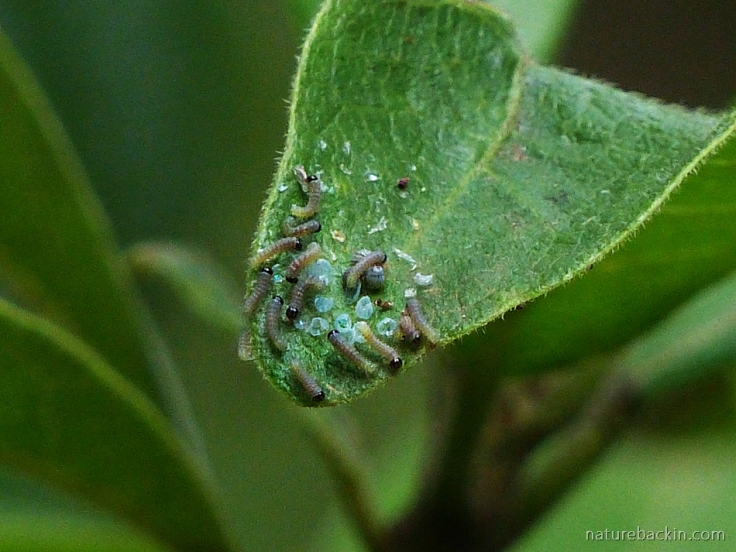
Despite the predations of the ladybird larvae, enough butterfly eggs remained to hatch into tiny caterpillars/larvae

The larvae (caterpillars) are gregarious and feed on the top of the leaves in clusters. The caterpillars grew steadily and soon started sporting tiny spines along the length of their bodies

At a later stage in their development, the larvae/caterpillars of the Blood-red Acraea butterfly are even spinier. The caterpillars slowly skeletonise the leaves. No permanent damage is done to the host plant by the caterpillars eating the leaves. On the contrary, caterpillar droppings fall to the ground fertilising the host plant
Acraea butterflies are known generally as bitter acraeas because they are distasteful to predators. Some butterflies, both as larvae and as adults, are poisonous to predators on account of their larval food plants containing toxins, and some butterflies in their adult phase can convert plant materials that they ingest to toxins that are distasteful to potential predators. Many caterpillars and butterflies that are toxic are brightly coloured as a warning to predators.
The Blood-red Acraea are a good illustration of this colourful warning. According to Steve Woodhall, the species is able to concentrate cyanide molecules that occur in the leaves of the African dog rose. However, some species of green cuckoos seem to be impervious and are able to eat the caterpillars. See also my post on Emerald cuckoos eating Processionary caterpillars here https://naturebackin.com/2018/05/31/african-emerald-cuckoo-feasts-on-hairy-caterpillars/

Here is a Blood-red Acraea caterpillar/larvae in its final stage before pupating. A leaf with a clutch of butterfly eggs that have turned colour can be seen below the caterpillar
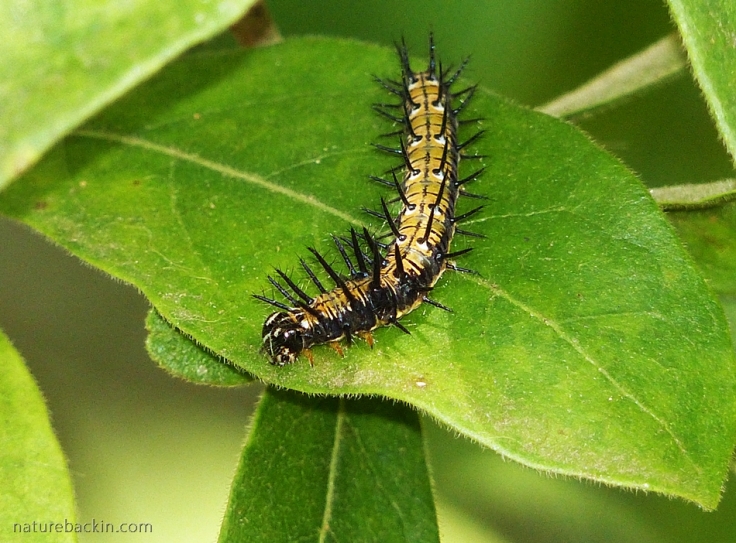
The caterpillar’s conspicuous looks advertise its distastefulness. The spines alone look off-putting

On one of my visits to the dog rose plant, I eventually noticed a Blood-red Acraea pupa, the next stage in the life cycle of the butterfly. Because the pupae are toxic to most predators they can afford to be conspicuous and brightly coloured
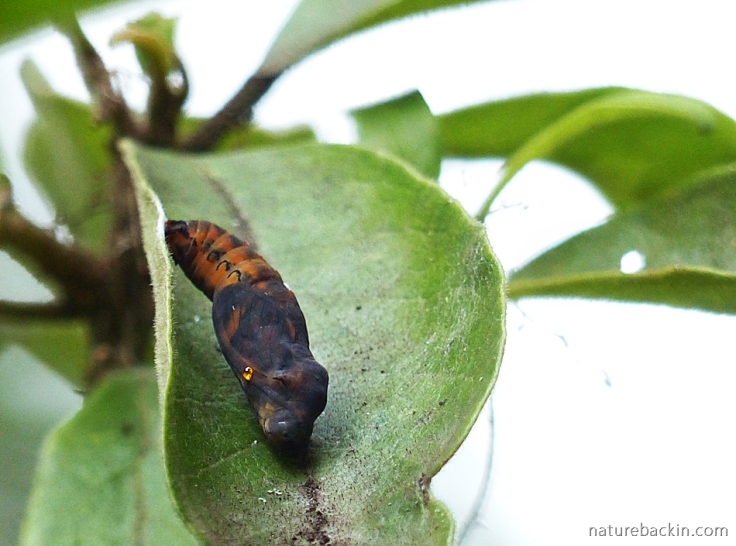
However, the colour of this pupa darkened and it started to droop. A drop of fluid is visible in this photograph. Each day I anxiously visited to check on the pupa, and its condition seemed to deteriorate
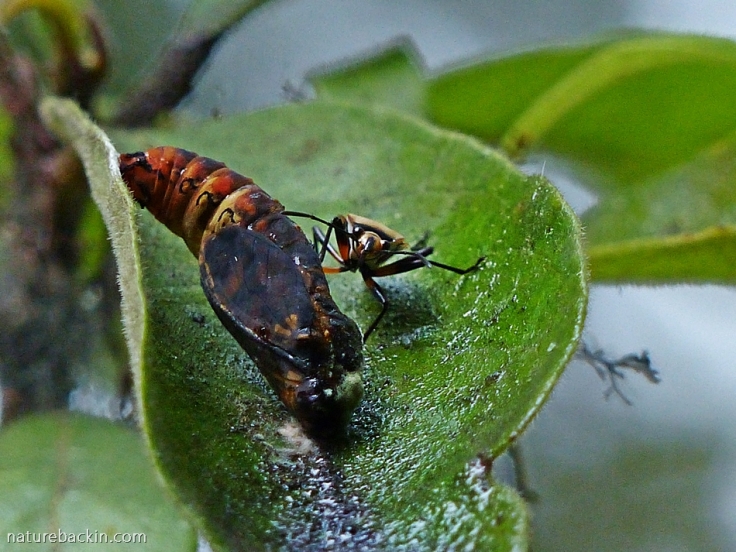
Could this assassin bug be the reason for the deterioration, or was it attracted to the pupa only after it started to leak fluid? This assassin bug remained with the pupa feeding off it for several days until what remained of the increasingly desiccated pupa broke off
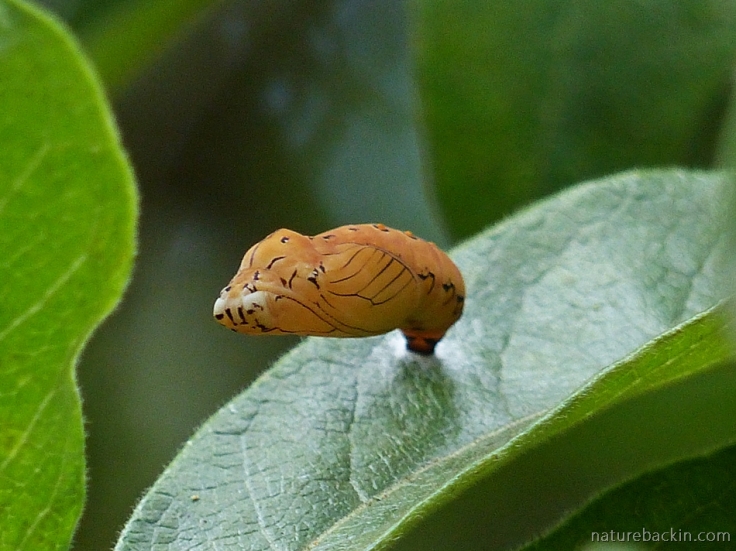
Another pupa on the sunny side of the African dog rose tree has remained healthy since I first spotted it a week ago and I will continue monitoring its progress
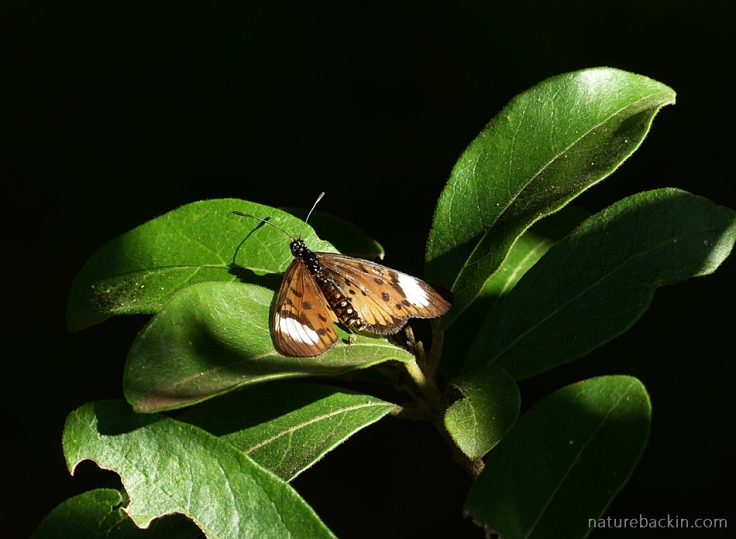
During my visits to the dog rose tree I kept a constant look out for butterflies. The usually drabber females are harder to see than the red males. This female Blood-red Acraea settled with her wings spread showing her conspicuous white wing patches. I wondered if she did this to attract the attention of a male, or perhaps they use pheromones to attract mates and the visual display counts for less?
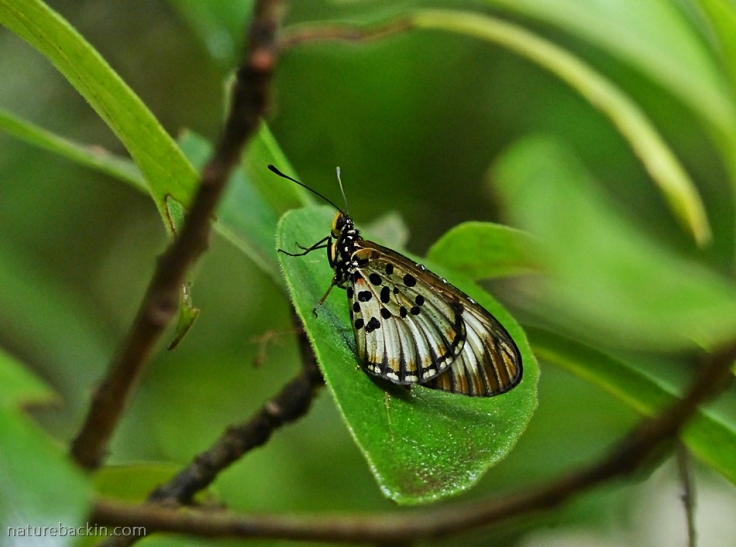
There is considerable variation in the colour of female Blood-red Acreas. For example, this female is browner in colour than the one I photographed laying eggs. Apparently some females can be red in colour, but they still have white wing patches on the upper wings and these white patches are absent in the males
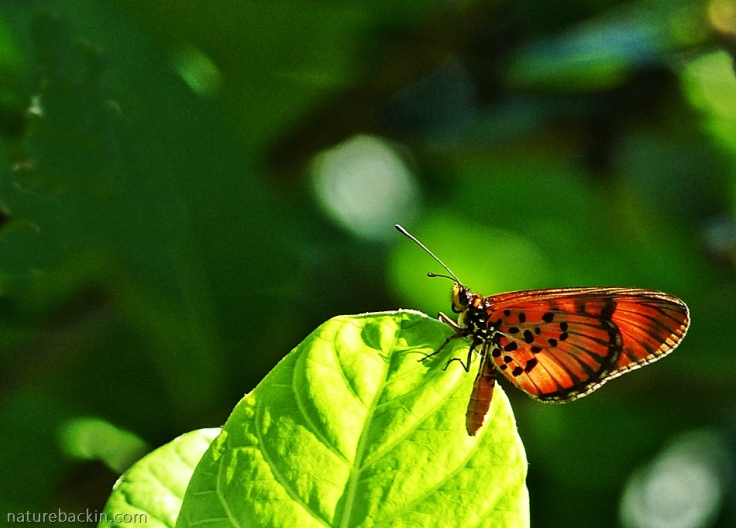
And here is a male Blood-red Acraea perching high on a shrub neighbouring the African dog rose. The male butterflies flit about the dog rose, seldom alighting, and when they do more often than not they are chased off by another male and they fly off fast, tailing each other in tumbling circles

Photographed in another shrub next to the dog rose, this male Blood-red Acraea spreads its wings in the bright morning sun
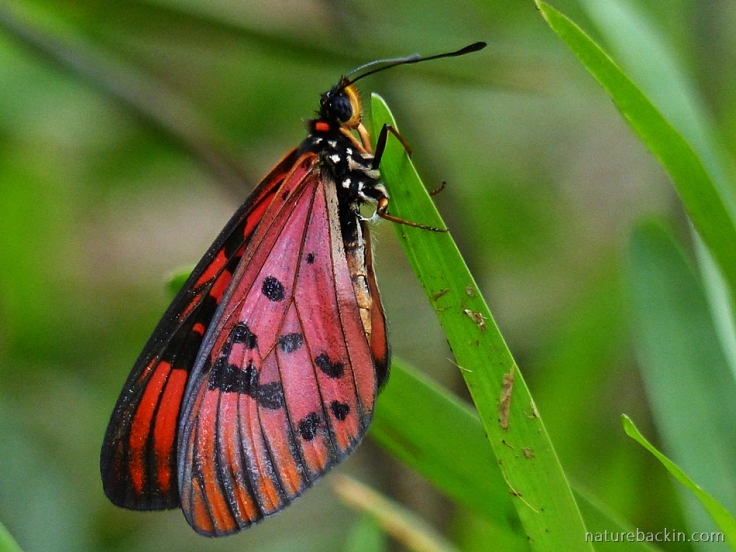
This male Blood-red Acraea was uncharacteristically resting on a blade of grass. I wondered if perhaps it had recently emerged from a pupa
I am not sure if I am noticing Blood-red Acraeas living on our African dog rose this year because there are more than there were before, or if I have just become more observant. I think it is possible that it has taken time for butterflies to find this larval host tree – the tree is about 15 years old and has been slow to become established – and so the tree is attracting more butterflies over time. By the way, all the photos in this blog post were taken during March 2019.
One of the joys of gardening for wildlife is that when one sees caterpillars eating the leaves of a host plant, rather than groaning and reaching for weapons of destruction such as poisons or secateurs, instead one celebrates.
I hope that more and more of us lucky enough to have gardens start embracing such possibilities for celebration and see our gardens as hosts for a variety of plants, including a rich diversity of native plants upon which so many of our wild creatures utterly depend. These plants in turn host a rich diversity of insects, birds and other creatures. How nice to learn how to become a small part of such a rich tapestry of life.
Sources:
Woodhall, Steve. 2013. Butterflies of South Africa. Pocket Guide. Cape Town: Struik Nature; Woodhall, Steve. [n.d.] Kloof’s top 10 butterflies. The Leopard’s Echo. https://le.kloofconservancy.org.za/kloofs-top-10-butterflies-steve-woodhall/; Woodhall, Steve. [n.d.] What do butterflies eat? The Leopard’s Echo. https://le.kloofconservancy.org.za/what-do-butterflies-eat/
Posted by Carol

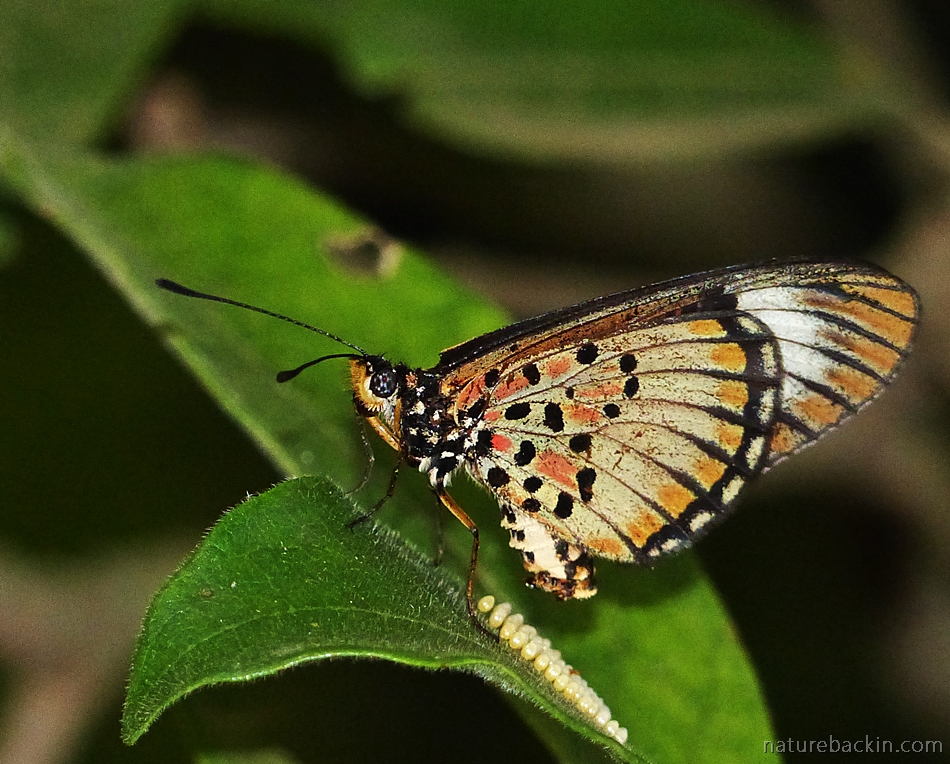







April 7, 2019 at 7:05 pm
Absolutely Fascinating! Your garden is alive!!
LikeLike
April 11, 2019 at 2:41 pm
Thanks Lizam. I am still in the habit of checking almost daily on all the life in this particular shrubby tree.
LikeLiked by 1 person
April 11, 2019 at 6:14 pm
So special, I also try to do daily checkups in my garden.
LikeLiked by 1 person
April 2, 2019 at 9:25 am
Wow Carol, this was indeed extremely informative! Wonderful pictures as well!
LikeLiked by 1 person
April 3, 2019 at 8:52 pm
Thanks Suzette. I became completely hooked on watching the cycle in progress!
LikeLike
April 2, 2019 at 9:12 am
Fabulous post, stunning images and great commentary. You are very fortunate to be able to observe the complete life-cycle in your garden.
LikeLiked by 1 person
April 3, 2019 at 8:51 pm
Yes it is very lucky to have been able to see the life-cycle on one shrub in one garden and during one month! Thanks so much for your kind and generous comment. Your butterfly (and other) photos are superb.
LikeLiked by 1 person
April 2, 2019 at 6:46 am
Terrific post Carol. Such great photos and information about the life cycle of this wonderfully-colored butterfly. I’ve seen some of this with passionvine butterflies here, but not the pupa stage, which I look for, but haven’t seen. You’re so right about not getting rid of the caterpillars because that’s getting rid of future butterflies. Most healthy plants will comfortably survive caterpillar activity unless it’s a biblical infestation.
LikeLiked by 1 person
April 3, 2019 at 8:45 pm
Thanks very much Graham. The pupae do seem to be hard to find. With all the activity in this shrub, I only managed to find 3 pupae. I agree that most healthy host plants seem to cope well with their caterpillar guests, and some host plants even seem to benefit from the “pruning” conferred on them by caterpillars and go on to produce a rich flush of new leaves when the time is right.
LikeLiked by 1 person
April 1, 2019 at 6:40 pm
Wow! That’s amazing!
LikeLiked by 1 person
March 31, 2019 at 3:53 am
What an utterly fascinating post, Carol, and how wonderful that you were able to capture the entire life cycle of these beauties!
LikeLiked by 1 person
March 31, 2019 at 6:05 am
And although I missed seeing the actual process, yesterday it appeared that the butterfly emerged from the healthy pupa, which is great. All that remains is the empty and split casing.
Our dogs are puzzled that I spend so much time apparently rooted to the spot staring into the vegetation 🙂
LikeLiked by 1 person
March 30, 2019 at 4:56 am
What a delightful post! The attention to detail was so informative. I can’t but help suspect that our Monarch Butterflies share the strategy of your Blood Red Acraea. Monarchs need Milkweed in order to propagate, the milkweed in turn makes them taste very bitter to discourage predators. With industrial farming practices encouraging the elimination of milkweed, the Monarchs are said to be declining. We planted native milkweed to try to help them out. I’ve been waiting impatiently to see if the milkweed grows.
LikeLiked by 1 person
March 30, 2019 at 10:05 am
Thanks Gunta. I hope the milkweed flourishes and in time the butterflies will follow.
LikeLike
March 29, 2019 at 9:48 pm
Wow!! A fantastic series of pics!!
LikeLiked by 1 person
March 30, 2019 at 9:57 am
Thanks very much. It was kind of satisfying to be able to see and record so much of the process.
LikeLiked by 1 person
April 1, 2019 at 9:22 pm
I bet! Must have been so fascinating
LikeLiked by 1 person
March 29, 2019 at 3:01 pm
I learn so much from your posts and your wonderful photos. And such a good example of what we can observe if we focus on a small environment.
LikeLiked by 1 person
March 29, 2019 at 7:07 pm
It never ceases to surprise me what one sees if one adjusts one’s perspective. Thanks Sandra.
LikeLiked by 1 person
March 29, 2019 at 12:50 pm
I am impressed with the full pictorial story you told.
LikeLiked by 1 person
March 29, 2019 at 7:06 pm
Thanks very much Sherry. I am still hoping to see a butterfly emerging from the pupa, but that would be extremely lucky.
LikeLike
March 29, 2019 at 9:21 am
👌👌👌Very informative with brilliant pictures! Personally I like caterpillars.
LikeLiked by 1 person
March 29, 2019 at 7:01 pm
I also like caterpillars 🙂 Thanks Simone.
LikeLiked by 1 person
March 29, 2019 at 7:45 am
As always so beautifully written and observed, worlds within worlds, simply magical Carol! Thank you!
LikeLiked by 2 people
March 29, 2019 at 7:00 pm
Worlds with worlds is an apt description. Thanks Christeen.
LikeLiked by 1 person
March 29, 2019 at 6:04 am
Thanks Anne. It was nice to share my enjoyment observing these creatures.
LikeLike
March 29, 2019 at 4:22 am
A thoroughly enjoyable – and informative – read! Your patience is remarkable.
LikeLiked by 1 person
March 29, 2019 at 6:09 am
Thanks Anne. It was nice to share my enjoyment observing these creatures.
LikeLike
March 28, 2019 at 11:01 pm
Great job!
LikeLiked by 1 person
March 29, 2019 at 6:01 am
Thanks very much Sandy.
LikeLiked by 1 person
March 29, 2019 at 2:47 pm
Welcome!
LikeLiked by 1 person
March 28, 2019 at 9:54 pm
I’m impressed with your studious following of this butterfly’s life cycle with superb photos– interesting and informative!
LikeLiked by 2 people
March 29, 2019 at 6:01 am
Thanks Eliza – I felt more entertained and diverted than studious 🙂
LikeLiked by 1 person
March 29, 2019 at 2:12 pm
An excellent student of nature!
LikeLiked by 1 person
March 29, 2019 at 7:06 pm
🙂
LikeLike
March 28, 2019 at 9:45 pm
WOW! Perfect captures and beautiful photos. Thanks for sharing.
LikeLiked by 1 person
March 29, 2019 at 5:59 am
Thanks very much. It has been a pleasure to share these sightings.
LikeLike
March 28, 2019 at 9:21 pm
As ever, fascinating stuff. You’ve found a veritable zoo there!
LikeLiked by 1 person
March 28, 2019 at 9:24 pm
Thanks Margaret. Its incredible what goes on even in one garden shrub!
LikeLiked by 2 people